Review for Utawarerumono: Volume 4 - The Price of Freedom
Introduction
With this fourth volume of Utawarerumono, we pass the halfway point of the series. Around this point, I usually have an idea of where a series is going, its ground rules and what it's trying to accomplish. Not so with Utawarerumono, which is proceeding at breakneck pace, with a story that constantly develops and evolves in totally unexpected ways. That isn't necessarily a bad thing. When the storytelling is as good as it is in Utawarerumono, there's a certain pleasure in grabbing the tiger by the tail and holding on for dear life. And have you seen the size of the tiger in Utawarerumono? The problem with such a rapidly developing story is that it's entirely possible to develop it completely off the rails. That's why each subsequent volume that I watch is approached with such enthusiasm and trepidation. Anything can happen in the next 100 minutes.
Utawarerumono is a fantasy series set in a strange world. It's based on a PC game, but before you recoil in horror, it's one of those narrative adventure PC games that the Japanese are so fond of, barely interactive animated storybooks, with sex scenes. This anime ditches the sex to produce something a little more appropriate for a broader audience. This is a strange world, populated with dog-eared people, strange animals, very real deities, oppressive governments, and on the verge of war. It's in this world that a masked stranger awakes. Hakuoro has no memory of his past, but a mask is affixed to his face, impossible to remove. He wakes in the village of Yamayura, healed and nursed back to health by a young girl named Eluluu, and is taken to heart by the kindly village people. Against all the adversities and challenges this harsh world throws against the people of Yamayura, this noble, enigmatic man becomes a beacon of hope, and a source of strength. But this is just the first step for Hakuoro to take towards his destiny of changing the world.
The next four episodes are presented on this disc from ADV.
15. End of the Banquet
The army forms up at the border with Shikeripechim, the fog lifts and they find that they are facing the combined might of Niwe's forces. They are seriously outnumbered, it's a battle that they cannot win, but victory isn't the aim. They just have to buy time. For Hakuoro, Touka, Karula, and Eluluu have taken a small force to the Shikeripechim capital, to confront Niwe while he's undefended, and to end the war where it started. But Niwe has been expecting them, a force is waiting for them, and Hakuoro is set to be the prize attraction in Niwe's gladiatorial circus. Niwe's expecting to awaken the beast that lies in Hakuoro's heart, but he has no idea what that actually means.
16. At the End of the Battle
A month has passed since the end of the war, and the war torn nations are rebuilding. Relations between Tuskuru and Kuccha Keccha are heading in the right direction, and people are getting used to the idea of a universal peace. All except Hakuoro that is, who is haunted by nightmares of that final battle, and tormented by the ash-strewn wasteland that exists where the Shikeripechim capital used to be, a capital to which the Shikerpechim refugees insist on returning. While Hakuoro tries to sort out his feelings, he's being spied upon. An Evankulga named Genjimaru insists that he meets the ruler of Kunekamun, a young sovereign named Kuuya Amrulineulka.
17. The Young Sovereign
Kuuya is interested in Hakuoro, wants to meet this legendary upstart who came from nowhere to rule a nation and defeat powerful rivals. This brash and outspoken ruler has specific ideas of how the world is, and how it should be, that are completely at odds with what Hakuoro has learned, and like Hakuoro, Kuuya remains hidden behind a mask. The people of Tuskuru finally have time for leisure on their hands, which leaves a lot of time for Hakuoro and Kuuya's summit meetings. Hakuoro is surprised when he finally learns who Kuuya is beneath the mask.
18. The Rebel Army
There's been a rebellion in Na Tuunk. The slaves have gotten loose and have organised themselves into an army, fighting the good fight against their former overseers. Delihourai of the Karulawatarei people is leading the insurrection. Karulawaterei? Could that mean that when Karula asks Hakuoro to help the rebels, there's more to it than just doing the right thing? If she's willing to give everything up, in exchange for Tuskuru's aid, it must be important to her. But having just fought two major wars, the people of Tuskuru need time to heal and recover. So Karula puts plan B into effect, kidnapping Hakuoro. Only Urutori discovers her, then Eluluu, and then Aruruu, and pretty soon there's a whole expeditionary force sneaking out of the palace by night. It isn't going to be easy though, as Delihourai is a proud warrior who doesn't want outside help, despite being outnumbered, while the leader of Na Tuunk is just waiting for Karula to return.
Picture
This being a Region 1 disc, Utawarerumono gets a 1.78:1 anamorphic transfer of the NTSC variety. It means a slightly lower resolution than PAL discs, and a greater prevalence of aliasing, but it also means that the image is clear, sharp, and colourful, and the animation is smooth, and free of ghosting and judder. Utawarerumono is an interesting animation, period fantasy as it is, it reminds me somewhat of Inuyasha, with its simplicity of character designs, and wholesome bright, primary colours. That said, there is something of a more atmospheric aesthetic to the animation, it's much more detailed and vivid, and with the fantasy setting, there's something Ghibli-esque about it, reminiscent of films like Nausicaa and Princess Mononoke. All in all, it's a very pleasant show to watch. That's with the exception of crowd and battle sequences. Where there are a lot of people on screen at any one time, and shown at a distance, the animators have used something akin to a 3D RTS graphics engine to render the crowds in CGI, and the graphics do tend to stick out like a sore thumb. Also when the camera gets a little too close, the uniformity of features becomes apparent.
Sound
Utawarerumono comes in DD 5.1 English and DD 2.0 Japanese stereo, along with optional translated subtitles, and a signs only track. In a nice move, the episode titles get a subtitle translation, but in an unconventional font that very much suits the look of the show. The dialogue is clear in both versions, and the show gets some very earthy, folk style music, along with a couple of very pleasant theme songs. I was happy enough with the Japanese version, which had some memorable character voices. Not so much for the English dub, which is pretty run of the mill for anime, not exactly standing out, but not really all that awful either.
Extras
Utawarerumono gets the usual jacket picture and animated menu, and this being a Region 1 disc, it also autoplays with ads for Anime Network and the now dead Newtype USA magazine.
Inside the very shiny green Amaray style case, you can read an eight-page booklet, which offers interviews with Executive Director of Animation, and Character Designer, Masahiko Nakata, Japanese Voice Actors Atsuko Tanaka (Karula), Kaya Miyake (Touka), and Miyuki Sawashiro (Aruruu).
On the disc you can find a three-page glossary, explaining the terms used in the show, and detailing some of the characters that you'll encounter.
Utawarerumono: The Story So Far is pretty self explanatory, although the 15-minute recap does get a comedy voiceover from Hakuoro, Eluluu and Aruruu. In a fast paced show like this, it's nice to have a recap and character rundown, although there is also a fair bit of background to the story taken from other sources than the anime, which expands the story's focus a little.
The Extended Episode Previews are just that, and there are 2 minutes worth here for all four episodes. These previews and the Story So Far featurette are in Japanese only.
There is a 30 second Character Art Gallery slideshow, as well as the textless credits.
Finally there are trailers for Gravion, 009-1, Ghost Train, Ah My Goddess: Season 2, Best Student Council, and Paniponi Dash.
Conclusion
Once again, Utawarerumono takes us in a wholly unexpected direction. After three volumes of warfare, rebellion, and Hakuoro's rapid ascension through the ranks of nobility, we get a comedy volume. This is a volume that is mostly devoted to the people of Tuskuru relaxing, healing, and recuperating, and that means taking time off from the vagaries of warfare and the harsh existence in this world, to unwind and goof around a lot. It's totally understandable of course, three major wars fought in succession, and in parallel do tend to take it out of a person, and it is important to take a step back from time to time, and get a different perspective on life, but I wasn't expecting Utawarerumono to actually show us.
Of course we have some serious stuff to deal with first, namely the war with Shikeripechim. If there has been a weak point of the series so far, it's Niwe, leader of the enemy nation, who has been an 'evil-laughing, moustache twirler grand villain' of the highest order. He certainly lacked the depth of the other characterisations, but as the arc comes to a close in the first episode of this disc, his theatrical villainy is unveiled as the outward sign of his sheer insanity. Sasante and Inkalla may have been hedonistic dictators, but they at least understood the value of their holdings. Niwe is willing to sacrifice his own people just to satisfy his lust for violence. He wants to see the depths of darkness and desperation in people, and when the wars aren't enough, he uses magic to unleash the killer instinct in his gladiators. These wars that Tuskuru has been drawn into have been for the sole purpose of unleashing the beast in Hakuoro. The twist here is that there actually is a beast in Hakuoro, a far more literal manifestation than the metaphor that Niwe is searching for, and he pays the ultimate price for his 'hobby'. Of course this is another aspect to Hakuoro that adds to the mystery of the man with a lost past.
It's almost back to normal service thereafter, as when Hakuoro isn't fighting a war, he's concerned about his hidden past, and worrying about the effect that fighting these wars has on him, and on his subjects. Before, the falsehood used to dupe the people of Kuccha Keccha was just that, a lie fashioned by Niwe to facilitate a bloody and brutal war. But the destruction of the Shikerpechim capital city, and the particularly brutal death of Niwe can't be passed off as a deception. Once again Hakuoro is deep in introspection about his true identity, and what it actually means. Except that no one else is wallowing in his despair. They are all relaxing, unwinding after the terrible wars, and finally rebuilding their respective nations. That, and the effort going into rebuilding, as well as Eluluu's eternal faith and optimism means that Hakuoro's introspection doesn't last too long.
Instead we get little slices of life, character vignettes that allow the peaceful sides to these characters to develop. There are one or two mysteries, such as why Camus is suddenly drinking water and behaving strangely, and the appearance of a strange, large beast in the forest, which no doubt will come to mean something in later volumes, but here is just throwaway plot development. The main theme is the arrival of Kuuya, a leader of another nation, but one who wants to meet and learn from Hakuoro, rather than start another war. The interesting thing is that Kuuya presents another worldview, different from the one that Hakuoro has learned since his awakening, one at odds with what Urutori and the Onkamiyamukai espouse, yet no less meaningful or heartfelt. They could just be two different religions, but I get the feeling that there is something fundamental about the difference between the two that will have a bearing later on.
As the disc ends, we get back to the cut and thrust of warfare and battle, but this keeps the light tone from the middle two episodes going a while longer, when Karula tries to convince Hakuoro to help, and winds up using her feminine wiles, which is when Eluluu walks in. A few days of silent treatment later, and Karula decides to expedite matters and just kidnap Hakuoro and take him with her to the rebel army. She quickly gets discovered, and it turns out that everyone wants to help, and it's soon an odd mercenary convoy heading to Na Tuunk. It turns out that Hakuoro has gathered quite the harem around him, as practically every female character joins him on the journey. It's only when we get to the actual war zone that things turn ugly, but not for our adventurers, rather Delihorai and the army that he leads, as they are promptly betrayed by one of their own. This story looks to develop Karula's character more, and fill in a lot of her back-story, and I look forward to seeing it resolved in the next volume.
Utawarerumono just keeps getting better and better. You may have been tiring of the warfare and bloodshed, especially as the battles are the more weakly animated segments of the show, but this volume gives us less war and more character, less angst and more comedy, and it's a perfectly timed breather from the serious aspects of statecraft and brinkmanship. This volume is just as much recommended as the previous three, and maybe even a tad more.
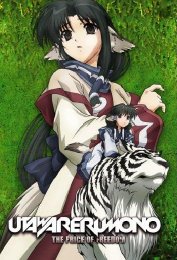
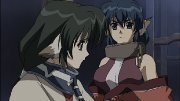
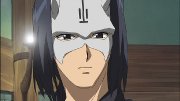

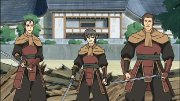

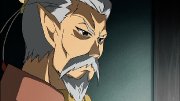

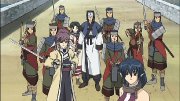


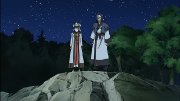

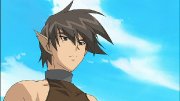



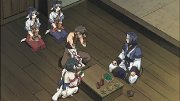

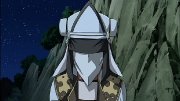

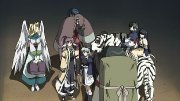


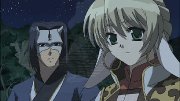
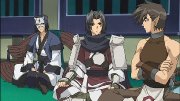
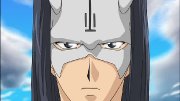
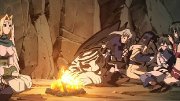
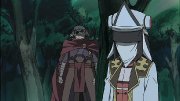
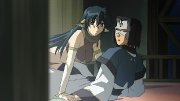
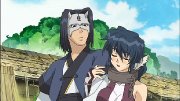











































Your Opinions and Comments
Be the first to post a comment!